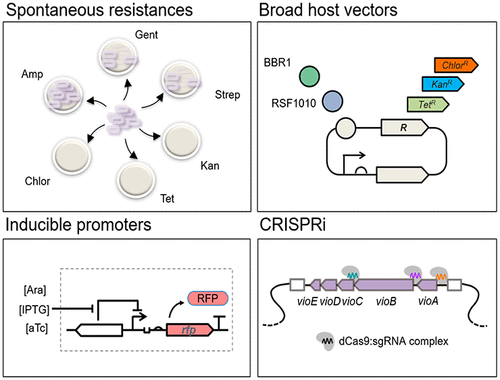当前位置:
X-MOL 学术
›
ACS Synth. Biol.
›
论文详情
Our official English website, www.x-mol.net, welcomes your feedback! (Note: you will need to create a separate account there.)
Toolkit Development for Cyanogenic and Gold Biorecovery Chassis Chromobacterium violaceum.
ACS Synthetic Biology ( IF 4.7 ) Pub Date : 2020-03-19 , DOI: 10.1021/acssynbio.0c00064 Lu Ting Liow 1, 2 , Maybelle Kho Go 1, 2 , Matthew Wook Chang 1, 2 , Wen Shan Yew 1, 2
ACS Synthetic Biology ( IF 4.7 ) Pub Date : 2020-03-19 , DOI: 10.1021/acssynbio.0c00064 Lu Ting Liow 1, 2 , Maybelle Kho Go 1, 2 , Matthew Wook Chang 1, 2 , Wen Shan Yew 1, 2
Affiliation

|
Chromobacterium violaceum has been of interest recently due to its cyanogenic ability and its potential role in environmental sustainability via the biorecovery of gold from electronic waste. However, as with many nonmodel bacteria, there are limited genetic tools to implement the use of this Gram-negative chassis in synthetic biology. We propose a system that involves assaying spontaneous antibiotic resistances and using broad host range vectors to develop episomal vectors for nonmodel Gram-negative bacteria. These developed vectors can subsequently be used to characterize inducible promoters for gene expressions and implementing CRISPRi to inhibit endogenous gene expression for further studies. Here, we developed the first episomal genetic toolkit for C. violaceum consisting of two origins of replication, three antibiotic resistance genes, and four inducible promoter systems. We examined the occurrences of spontaneous resistances of the bacterium to the chosen selection markers to prevent incidences of false positives. We also tested broad host range vectors from four different incompatibility groups and characterized four inducible promoter systems, which potentially can be applied in other Gram-negative nonmodel bacteria. CRISPRi was also implemented to inhibit violacein pigment production in C. violaceum. This systematic toolkit will aid future genetic circuitry building in this chassis and other nonmodel bacteria for synthetic biology and biotechnological applications.
中文翻译:

蓝绿色和金色生物回收底盘紫细菌的工具包开发。
紫罗兰色杆菌由于其生氰能力和通过电子废物中金的生物回收在环境可持续性方面的潜在作用,最近引起人们的关注。但是,与许多非模型细菌一样,在合成生物学中使用这种革兰氏阴性底盘的遗传工具也很有限。我们提出了一种系统,该系统涉及分析自发性抗生素抗性并使用广泛的宿主范围载体来开发非模型革兰氏阴性细菌的附加型载体。这些开发的载体可随后用于表征基因表达的诱导型启动子,并实施CRISPRi抑制内源基因表达,以进行进一步研究。在这里,我们开发了第一个用于假丝酵母的附加体遗传工具包,该工具包包含两个复制起点,三个抗生素抗性基因,和四个诱导型启动子系统。我们检查了细菌对所选选择标记的自发抗性的发生,以防止假阳性的发生。我们还测试了来自四个不同不相容性组的广泛宿主范围的载体,并表征了四个诱导型启动子系统,这些系统可能可用于其他革兰氏阴性非模型细菌。CRISPRi还被实施来抑制紫堇中紫堇色素的产生。这个系统的工具包将有助于未来在该底盘和其他非模型细菌中建立遗传电路,以用于合成生物学和生物技术应用。我们还测试了来自四个不同不相容性组的广泛宿主范围的载体,并表征了四个诱导型启动子系统,这些系统可能可用于其他革兰氏阴性非模型细菌。CRISPRi还被实施来抑制紫堇中的紫堇色素生成。这个系统的工具包将有助于未来在该底盘和其他非模型细菌中建立遗传电路,以用于合成生物学和生物技术应用。我们还测试了来自四个不同不相容性组的广泛宿主范围的载体,并表征了四个诱导型启动子系统,这些系统可能可用于其他革兰氏阴性非模型细菌。CRISPRi还被实施来抑制紫堇中紫堇色素的产生。这个系统的工具包将有助于未来在该底盘和其他非模型细菌中建立遗传电路,以用于合成生物学和生物技术应用。
更新日期:2020-04-23
中文翻译:

蓝绿色和金色生物回收底盘紫细菌的工具包开发。
紫罗兰色杆菌由于其生氰能力和通过电子废物中金的生物回收在环境可持续性方面的潜在作用,最近引起人们的关注。但是,与许多非模型细菌一样,在合成生物学中使用这种革兰氏阴性底盘的遗传工具也很有限。我们提出了一种系统,该系统涉及分析自发性抗生素抗性并使用广泛的宿主范围载体来开发非模型革兰氏阴性细菌的附加型载体。这些开发的载体可随后用于表征基因表达的诱导型启动子,并实施CRISPRi抑制内源基因表达,以进行进一步研究。在这里,我们开发了第一个用于假丝酵母的附加体遗传工具包,该工具包包含两个复制起点,三个抗生素抗性基因,和四个诱导型启动子系统。我们检查了细菌对所选选择标记的自发抗性的发生,以防止假阳性的发生。我们还测试了来自四个不同不相容性组的广泛宿主范围的载体,并表征了四个诱导型启动子系统,这些系统可能可用于其他革兰氏阴性非模型细菌。CRISPRi还被实施来抑制紫堇中紫堇色素的产生。这个系统的工具包将有助于未来在该底盘和其他非模型细菌中建立遗传电路,以用于合成生物学和生物技术应用。我们还测试了来自四个不同不相容性组的广泛宿主范围的载体,并表征了四个诱导型启动子系统,这些系统可能可用于其他革兰氏阴性非模型细菌。CRISPRi还被实施来抑制紫堇中的紫堇色素生成。这个系统的工具包将有助于未来在该底盘和其他非模型细菌中建立遗传电路,以用于合成生物学和生物技术应用。我们还测试了来自四个不同不相容性组的广泛宿主范围的载体,并表征了四个诱导型启动子系统,这些系统可能可用于其他革兰氏阴性非模型细菌。CRISPRi还被实施来抑制紫堇中紫堇色素的产生。这个系统的工具包将有助于未来在该底盘和其他非模型细菌中建立遗传电路,以用于合成生物学和生物技术应用。


























 京公网安备 11010802027423号
京公网安备 11010802027423号